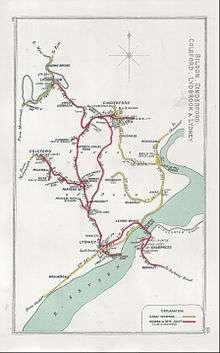Tufts Junction
| Dean Forest Railway | ||||||||||||||||||||||||||||||||||||||||||||||||||||||||||||||||||||||||||||||||||||||||||||||||||||||||
|---|---|---|---|---|---|---|---|---|---|---|---|---|---|---|---|---|---|---|---|---|---|---|---|---|---|---|---|---|---|---|---|---|---|---|---|---|---|---|---|---|---|---|---|---|---|---|---|---|---|---|---|---|---|---|---|---|---|---|---|---|---|---|---|---|---|---|---|---|---|---|---|---|---|---|---|---|---|---|---|---|---|---|---|---|---|---|---|---|---|---|---|---|---|---|---|---|---|---|---|---|---|---|---|---|
| ||||||||||||||||||||||||||||||||||||||||||||||||||||||||||||||||||||||||||||||||||||||||||||||||||||||||
Tufts Junction was a junction on the Severn and Wye Railway between Lydney Town and Whitecroft. The junction is now on the Dean Forest Railway between Norchard and Whitecroft.
History

A 1911 Railway Clearing House map of railways in the vicinity of Tufts Junction
The Junction is where the Mineral loop and branch to Parkhill Colliery branched off from the main Severn and Wye line from Lydney to Lydbrook and Cinderford. The single line diverged into three. All three lines were closed between the 1950s and 1970s.
The main line through the junction has been restored by the Dean Forest Railway which runs between Lydney Junction and Parkend.
Coordinates: 51°43′49″N 2°32′10″W / 51.73034°N 2.53603°W
This article is issued from Wikipedia - version of the 3/15/2013. The text is available under the Creative Commons Attribution/Share Alike but additional terms may apply for the media files.